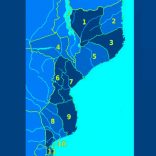Mozambique: Vitano Singano's party and wife do not confirm his death - O País
Mozambique: Nyusi launches literacy initiative – AIM

Photo: Conselho Executivo Provincial de Nampula
Mozambican President Filipe Nyusi on Friday at Carapira, in Monapo district, in the northern province of Nampula, launched an initiative to reduce the illiteracy rate from the current figure of 39 per cent, to 26 per cent by 2024, and 23 per cent by 2029.
The strategy is to be carried out by the Ministry of Education, in collaboration with the office of the First Lady. Isaura Nyusi. Its target is, over this period, to teach 4.5 million youths and adults to read and write. Special attention will be paid to women and girls, and to people with special educational needs.
The literacy drive will pay particular attention to the northern provinces of Cabo Delgado, Nampula and Niassa, and to Tete and Zambezia in the central part of the country, where illiteracy rates are above the national average.
Nyusi said that the initiative, entitled “Plan of Action to Speed up Literacy Teaching among Young People and Adults”, is justified because, despite positive results in adult literacy, the challenge of eliminating illiteracy in Mozambique remains.
“The Mozambican government has approved the plan and it is our desire that, in the short term, illiteracy will pass into history in Mozambique, just as colonial rule has”, said the President. “To this end, we are urging all the leaderships, throughout the country, to encourage the literacy drive, working with households, in the neighbourhood, the locality, the administrative post, the district and the province, to ensure that in the matrix of our leadership can figure the fact that we are free of illiteracy”.
He gave the statistics that show where the worst problems lie – Cabo Delgado (where 60.7 per cent of the adult population is illiterate), Niassa (58 per cent), Nampula (56 per cent), Tete (55.2 per cent) and Zambezia (53.9 per cent).
“Our effort to educate and train Mozambicans has had visible results, expressed in more than 61 per cent of the population being literate”, declared Nyusi. “But the challenge of eliminating illiteracy is still enormous, and the steps in reducing illiteracy are very slow. There are still sharp inequalities between the provinces in which illiteracy most affects the 15-19 year age group, hence young and economically active people”.
“This plan reflects our vision of literacy teaching, which cannot be summarised just as teaching reading, writing and basic arithmetic”, he added. “The purpose is to increase the capacity of the literacy student to employ knowledge, skills and values and to deal with contexts and situations that are constantly changing throughout his life”.












Leave a Reply
Be the First to Comment!
You must be logged in to post a comment.
You must be logged in to post a comment.